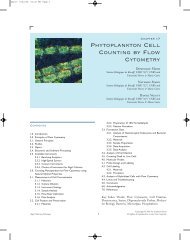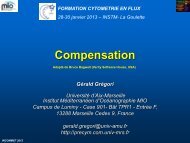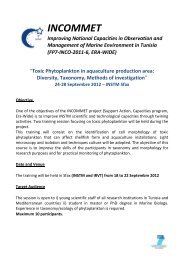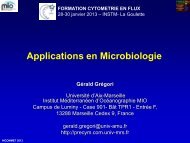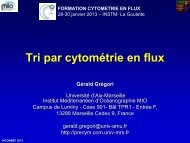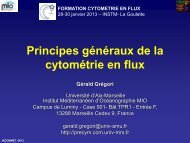Eukaryotic Picoplankton in Surface Oceans - incommet
Eukaryotic Picoplankton in Surface Oceans - incommet
Eukaryotic Picoplankton in Surface Oceans - incommet
Create successful ePaper yourself
Turn your PDF publications into a flip-book with our unique Google optimized e-Paper software.
without the clon<strong>in</strong>g step, are open<strong>in</strong>g new dimensions<br />
to gene-targeted studies (13). F<strong>in</strong>ally,<br />
sequenc<strong>in</strong>g of environmental DNA obviat<strong>in</strong>g<br />
the PCR step can also detect phylogenetic<br />
markers that describe <strong>in</strong> situ diversity (59).<br />
Distribution and abundance<br />
Flow cytometry<br />
FISH<br />
Phylogenetic diversity<br />
Clone libraries<br />
Annu. Rev. Microbiol. 2011.65:91-110. Downloaded from www.annualreviews.org<br />
by CSIC - Consejo Superior de Investigaciones Cientificas on 09/27/11. For personal use only.<br />
Laboratory Studies with<br />
Isolated Picoeukaryotes<br />
Some groups detected <strong>in</strong> molecular surveys<br />
have cultured representatives (39, 82), so these<br />
stra<strong>in</strong>s are good candidates for ultrastructural,<br />
physiological, and genomic studies. Ecophysiology<br />
<strong>in</strong>vestigates the effect of environmental<br />
parameters, resources, or natural enemies on<br />
cell activity. Critical factors for PPE are the <strong>in</strong>tensity<br />
and quality of light or the uptake k<strong>in</strong>etics<br />
of <strong>in</strong>organic nutrients, whereas for HPE critical<br />
factors are the size, quality, and quantity of prey<br />
(39, 48). In general, the high surface/volume ratio<br />
of small cells derives from high absolute and<br />
specific growth rates, high aff<strong>in</strong>ity for diluted<br />
compounds, and better fitness with respect to<br />
larger cells <strong>in</strong> oligotrophic environments (66).<br />
Genome projects of cultured stra<strong>in</strong>s are pivotal<br />
for understand<strong>in</strong>g evolutionary relationships,<br />
metabolism, and development of specific<br />
traits. About 10% of the 1,508 published<br />
genomes are eukaryotic and only 38 are of<br />
protists (and 243 are <strong>in</strong> progress; http://www.<br />
genomesonl<strong>in</strong>e.org/). Free-liv<strong>in</strong>g mar<strong>in</strong>e<br />
protists <strong>in</strong>clude four pras<strong>in</strong>ophyte stra<strong>in</strong>s, two<br />
diatom stra<strong>in</strong>s, and one choanoflagellate stra<strong>in</strong><br />
(41, 63, 86). Each genome has been analyzed<br />
from a different perspective, <strong>in</strong>clud<strong>in</strong>g gene<br />
organization, speciation patterns, and the<br />
orig<strong>in</strong> of multicellularity, and may lead to new<br />
hypotheses to be tested experimentally. Together,<br />
ecophysiological and genomic studies<br />
contribute to identify<strong>in</strong>g the traits that make an<br />
organism successful <strong>in</strong> the environment (48).<br />
L<strong>in</strong>k<strong>in</strong>g Diversity and Function for<br />
Uncultured Groups<br />
A large fraction of <strong>in</strong> situ diversity is not represented<br />
<strong>in</strong> cultures, and it is urgent to try orig<strong>in</strong>al<br />
strategies to isolate <strong>in</strong>terest<strong>in</strong>g picoeukary-<br />
Figure 3<br />
Molecular markers<br />
Microscopy<br />
Ecophysiology<br />
Genomics<br />
Cultures<br />
Ecology<br />
Biology of<br />
organisms<br />
Cultur<strong>in</strong>g the<br />
uncultured<br />
Evolution<br />
In situ experiments<br />
F<strong>in</strong>gerpr<strong>in</strong>t<strong>in</strong>g<br />
Metagenomics<br />
Metatranscriptomics<br />
Functional diversity<br />
Overview of approaches to <strong>in</strong>vestigate cell biology, ecology, and evolution of<br />
mar<strong>in</strong>e picoeukaryotes (and microorganisms <strong>in</strong> general), treat<strong>in</strong>g four ma<strong>in</strong><br />
study areas: abundance, phylogenetic diversity, functional diversity, and culture<br />
studies. Abbreviation: FISH, fluorescence <strong>in</strong> situ hybridization.<br />
otes (35). Nevertheless, some may be unculturable<br />
and, even <strong>in</strong> the best scenario, it is<br />
unlikely that we will ever have the whole <strong>in</strong><br />
situ diversity <strong>in</strong> culture. So, methods to address<br />
the function of uncultured picoeukaryotes<br />
are essential. A first approach clos<strong>in</strong>g the<br />
rRNA cycle is fluorescence <strong>in</strong> situ hybridization<br />
(FISH). This technique visualizes specific cells<br />
<strong>in</strong> natural assemblages, putt<strong>in</strong>g a face (cell size,<br />
shape) to uncultured clades and allow<strong>in</strong>g them<br />
to be quantified (56). When comb<strong>in</strong>ed with experiments<br />
and direct observations, FISH relates<br />
uncultured clades to given ecological roles<br />
(12, 57).<br />
Direct sequenc<strong>in</strong>g community DNA<br />
(metagenomics) or community RNA (metatranscriptomics)<br />
is revolutioniz<strong>in</strong>g microbial<br />
ecology, especially when comb<strong>in</strong>ed with highthroughput<br />
sequenc<strong>in</strong>g. Metagenomics reveals<br />
community gene repertoires and metabolic<br />
potential (21), whereas metatranscriptomics<br />
provides <strong>in</strong>sights <strong>in</strong>to realized functions (27).<br />
Functional profiles given by -omic approaches<br />
can be used as descriptors of community properties<br />
and for comparative purposes. Indeed,<br />
Ecophysiology:<br />
refers to functional<br />
properties of an<br />
organism important to<br />
understand<strong>in</strong>g its<br />
environmental<br />
adaptation<br />
Genome project:<br />
complete sequenc<strong>in</strong>g<br />
of the DNA of an<br />
organism to determ<strong>in</strong>e<br />
its gene content,<br />
metabolism,<br />
evolutionary orig<strong>in</strong>,<br />
and ecological<br />
adaptation<br />
FISH: fluorescence <strong>in</strong><br />
situ hybridization<br />
www.annualreviews.org • Mar<strong>in</strong>e Picoeukaryotes 97



